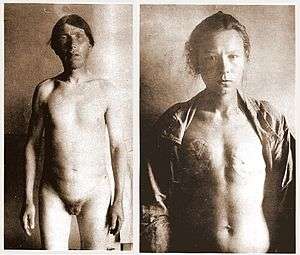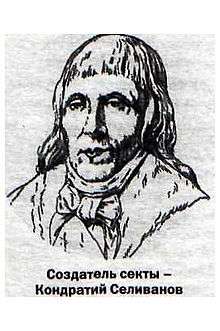Skoptsy
The Skoptsy (Russian: скопцы; singular скопец "castrate"; also transliterated as Skoptzy, Skoptzi, Skoptsi, Skopzi, Scoptsy, etc.) were a heretical sect, within the larger Spiritual Christianity movement in the Russian Empire, best known for practicing castration of men and the mastectomy of women in accordance with their teachings against sexual lust. The term is a descriptive one used by the official Russian Orthodox Church.
The movement emerged in the late 18th century. It reached the peak of its popularity in the early 20th century, with as many as 100,000 members, in spite of persecution by the imperial government. Repression under the Soviet Union resulted in the movement's fading into obscurity by the mid-20th century.
Beliefs and practices

Skoptsy is a plural of skopets, at the time the Russian term for "castrate" (in contemporary Russian, the term has become restricted to referring to the sect, in its generic meaning replaced by the loanwords yévnukh е́внух and kastrat кастрат).
The Skoptsy referred to themselves as the "White Doves" белые голуби. Their aim was the perfection of the individual, by eradicating Original Sin, which they believed had come into the world by the first coitus between Adam and Eve. They believed that human genitals were the true mark of Cain, and that the true message of Jesus Christ included the practice of castration, that Jesus himself had been a castrate, and that his example had been followed by the apostles and the early Christian saints.[1]
They believed that human genitals were a mark of Original Sin, more specifically, that after the expulsion from the Garden of Eden, Adam and Eve had the halves of the forbidden fruit grafted onto their bodies forming testicles and breasts. Thus, the removal of these sexual organs restored the Skoptsy to the pristine state before the Original Sin. In this the Skoptsy maintained that they were fulfilling Christ's counsel of perfection in Matthew 19:12[2] and 18:8–9.[3]
There were two kinds of castration: the "lesser" and "greater seal" (i.e. partial and complete castration). For men, "lesser" castration was the removal of the testicles only, while "greater" castration was the removal of the penis as well (emasculation). Men who did the "greater seal" used a cow-horn when urinating. The castrations and emasculations were made with primitive tools such as a shaving knife without using any anesthetic. The earliest records of mastectomy date from 1815. Usually only the breasts were amputated.[4]
History

The Skoptsy movement emerged in ca. the 1760s from the flagellant sect of the Khlysty. Its founder was a peasant, later known by the name of Kondratiy Ivanovich Selivanov, a former adherent of a Khlysty sect of one Akulina Ivanovna in the Oryol Governorate.[5] Selivanov had started his own sect in village of Sosnovka near Morshansk, styling himself "Son of God" and "Redeemer": The community of Selivanov's followers, numbered at 246 people, were put on trial in 1772. Selivanov was convicted of having persuaded thirteen other peasants to castrate themselves. He at first managed to escape, but he was apprehended in 1775 and exiled to Nerchinsk, Siberia. His followers organized to locate him and help him escape. He was found to live in Irkutsk, and managed to escape and move to Moscow in ca. 1795. In 1797, he moved to Saint Petersburg where, according to Skoptsy accounts he was interviewed by Tsar Paul I, to whom he revealed himself as his father, Peter III (who had been assassinated in 1762), following which Paul I had him confined to the madhouse at Obukhov hospital.
He was released in 1802, and for eighteen years, until 1820, he lived in Saint Petersburg, in the house of one of his disciples, receiving double homage as Christ and tsar, as he identified himself as both Tsar Peter III and as Christ Returned. Peter had been popular among the Raskolniks (schismatics, or dissidents) because he granted them liberty of conscience, and among the peasants because when pillaging the convents he divided their lands among the labourers. Selivanov claimed the title "God of Gods and King of Kings", and announced his accomplishment of the salvation of believers through castration.
Selivanov succeeded in gaining followers even among the upper classes of Saint Petersburg. When the Governor General of Saint Petersburg, Mikhail Miloradovich, learned that two of his nephews, as well as several members of the guards regiments and sailors, were members of the sect, he asked the imperial government to intervene. Eventually, in June 1820, it was decided to once again arrest Selivanov, and confine him to Evfimiev monastery in Suzdal, where he remained until his death in 1832, allegedly his hundredth year.[6] During his stay in Suzdal, his followers continued to plead for his release. Although this was denied, Selivanov was free to receive visitors in the monastery, and his followers worshipped him there. He also left writings, known under the title The Message (Послание) and Harvest (Страды), as well as nine letters addressed to the priest Sergeyev.
Despite the furious investigations of the Third Department (the tsar's secret police), Skoptsism did not disappear after Selivanov's death, and scandals continued to arise. The sect established a presence in Saint Petersburg, Moscow, Morshansk and Odessa, and later in Bukarest and Iași, where members of the sect had fled to due to the persecution by authorities. By 1866, the sect was reported as having 5,444 members (3,979 men and 1,465 women). Although Skoptisism prescribed castration as a precondition for entering paradise, only a minority of members (703 men and 100 women) had undergone bodily mutilation.[7] Alexandre Dumas, père, writes about the sect, calling them scopsis, towards the end of his account of his journey through Caucasia, "Le Caucase, Memoires d'un Voyage", 1858,[8] where he met them in Georgia. In the book The Idiot, Fyodor Dostoevsky mentions Skoptsy tenants in a boarding house. Dostoevsky also mentions Skoptsy in the 1872 novel Demons.
Repressive measures were tried along with ridicule: male Skoptsy were dressed in women's clothes and paraded with fools' caps on through the villages. In 1876, 130 Skoptsy were deported. To escape prosecution some of the sect emigrated, mostly to Romania, where some of them mixed with old believer exiles known as Lipovans. Romanian writer I.L. Caragiale acknowledges that toward the end of the 19th century all the horse-powered cabs in Bucharest were driven by Russian Skoptsy (Scopiţi in Romanian). Though the law was strict in Russia—every eunuch was compelled to register—Skoptsism did not abate in its popularity. The Skoptsy became known as moneylenders,[9] and a bench known as the "Skoptsy's Bench" stood in St. Petersburg for many years.
The Skoptsy may have had as many as 100,000 followers in the early 20th century, although repression continued and members of the sect were put on trial (New York Times 1910). Increased repression and collectivization under the Soviet Union reduced the numbers to a reported few thousand in 1929, when the authorities staged a widely-publicized mass trial against the sect.[10]
Leon Trotsky, in a report from Romania in 1913, wrote about the Skoptsy in the Dobruja region who worked as horse-cab drivers and played a predominant role in the local horse trade.[11] Patrick Leigh Fermor in The Broken Road describes his encounters (in 1933/4) with two Skapetz in a Budapest tavern and as a passenger in their horse-drawn cabs: "Their crass little blue eyes were embedded in wide, soft, smooth faces covered with tiny creases and wrinkles. They conversed in oddly high-pitched voices in a language that sounded at first like Bulgarian but soon turned out to be—judging by its shifting vowels and liquid sounds—Russian."[12] Olivia Manning in The Great Fortune (1960) describes the Skoptsy carriage drivers of Bucharest based on her visit in 1939.[13]
According to the Great Soviet Encyclopedia the sect still operated within the USSR in 1947.[14] It is believed to have mostly disappeared by the 1970s,[15] although there are reports of surviving communities in Latvia in the 1990s.[16] A small sect of so-called "spiritual Skoptsy" (духовные скопцы), ascetics who do not practice castration, survive in the North Caucasus.
See also
- Antisexualism
- Coitophobia
- Galli—eunuch priests of Cybele
- Origen—early Christian author who allegedly castrated himself
- Self-mutilation
- Sexual abstinence
- Skoptic syndrome—the wish to become a eunuch
- The Heaven's Gate sect also practiced castration
- Transgenderism
- Vissarion—contemporary Russian cult leader claiming to be the reincarnation of Christ
Notes
- ↑ Frick (2005), p. 456.
- ↑ Matthew 19:12: "For there are some eunuchs, which were so born from their mother's womb: and there are some eunuchs, which were made eunuchs of men: and there be eunuchs, which have made themselves eunuchs for the kingdom of heaven's sake. He that is able to receive it, let him receive it."
- ↑ "Matthew 18:8–9: "Wherefore if thy hand or thy foot offend thee, cut them off, and cast them from thee: it is better for thee to enter into life halt or maimed, rather than having two hands or two feet to be cast into everlasting fire. And if thine eye offend thee, pluck it out, and cast it from thee: it is better for thee to enter into life with one eye, rather than having two eyes to be cast into hell fire."
- ↑

- ↑ Селиванов, Кондратий in: Энциклопедический словарь Брокгауза и Ефрона (1890—1907).
- ↑ His year of birth was variously reported as 1720, 1730, 1732 and 1740. Селиванов, Кондратий in: Большая биографическая энциклопедия.
- ↑ F. von Stein (Gotha): Die Skopzensekte in Russland in ihrer Entstehung, Organisation und Lehre. Nach den zuverlässigsten Quellen dargestellt. In: Zeitschrift für Ethnologie – Organ der Berliner Gesellschaft für Anthropologie, Ethnologie und Urgeschichte, vol. 7 (1875),66–67.
- ↑ Dumas, Alexandre, père (1858). Le Caucase, Memoirs d'un Voyage.
- ↑ Staff writer (1910-10-06). "Skoptsy Members on Trial". The New York Times. p. 6. Retrieved 2007-12-19.
- ↑ Нехамкин С. Членовредители, 80 лет назад (1929 г.) в СССР прошли судебные процессы над сектой скопцов ("80 years ago (i.e., in 1929), there were trials against the Skoptsy sect in the USSR"), Аргументы недели. — № 11 (149), 19 March 2009.
- ↑ Leon Trotsky, The Balkan Wars 1912-13: The War Correspondence of Leon Trotsky, Sydney 1980
- ↑ Fermor, Patrick Leigh, "The Broken Road", at 158-59, 164-65, 168-69 (2013: New York Review Books) ( ISBN 9781590177549)
- ↑ Manning, Olivier (1960). The Great Fortune. Arrow. p. 30.
- ↑ Александр Кампов, Секты и сектантская идеология в России.
- ↑ Lane 1978
- ↑ Кон. ГАЙВОРОНСКИЙ, Скопский хутор "СМ", Riga, 22 August 1999.
References
- Anatole Leroy-Beaulieu, The Empire of the Tsars (Eng. trans., 1896), vol. iii.
- E. Pelikan, Geschichtlich-medizinische Untersuchungen über das Skopzentum in Rußland (Gießen, 1876)
- K. K. Grass, Die geheime heilige Schrift der Skopzen (Leipzig, 1904)
- K. K. Grass, Die russischen Sekten (Leipzig 1907 &c).
- Engelstein, Laura (1999). Castration and the heavenly kingdom: a Russian folktale. Ithaca, N.Y.: Cornell University Press. ISBN 0-8014-3676-1.
- Karl R. H. Frick: Licht und Finsternis. Gnostisch-theosophische und freimaurerisch-okkulte Geheimgesellschaften bis zur Wende des 20. Jahrhunderts, vol. 2; Marix Verlag, Wiesbaden 2005; ISBN 3-86539-044-7;
- Lane, Christel (1978). Christian Religion in the Soviet Union: a Sociological Study (Google Books). Albany, N.Y.: SUNY Press. pp. 94–95. ISBN 0-87395-327-4. Retrieved 2007-12-19.

External links
- Panchenko, Aleksandr. "Strange faith" and the blood libel
- The Castrati ("Skoptsy") Sect in Russia: History, Teaching and Religious Practice by Irina A. Tulpe and Evgeny A. Torchinov
- From Heresy to Harm: Self-Castrators in the Civic Discourse of Late Tsarist Russia by Laura Engelstein (Chapter 1 PDF)